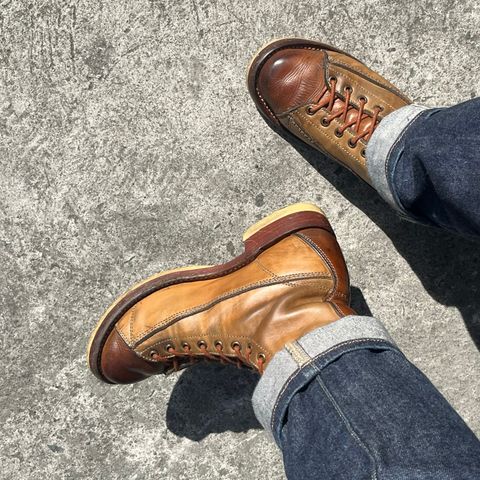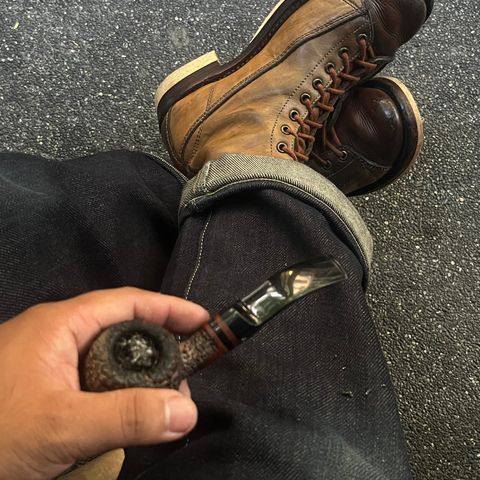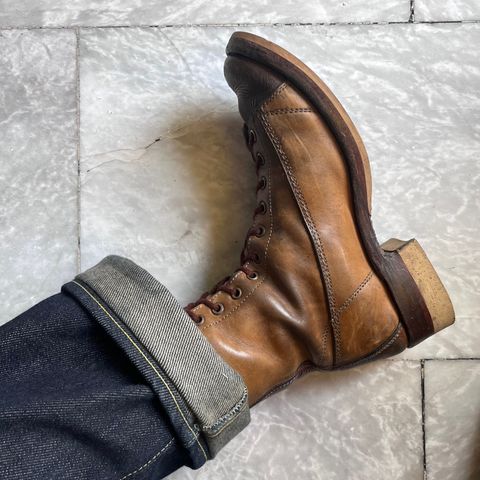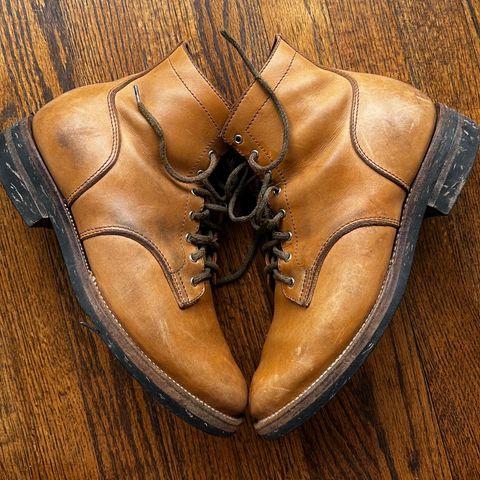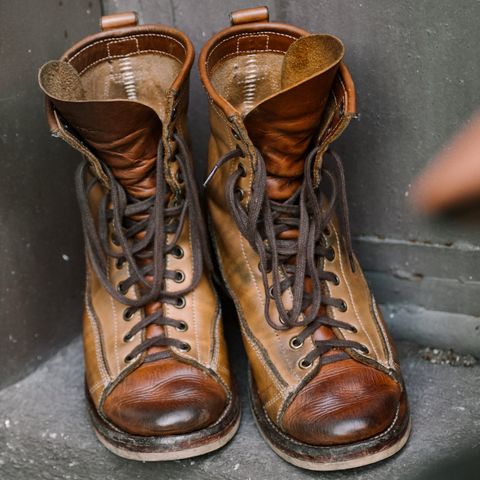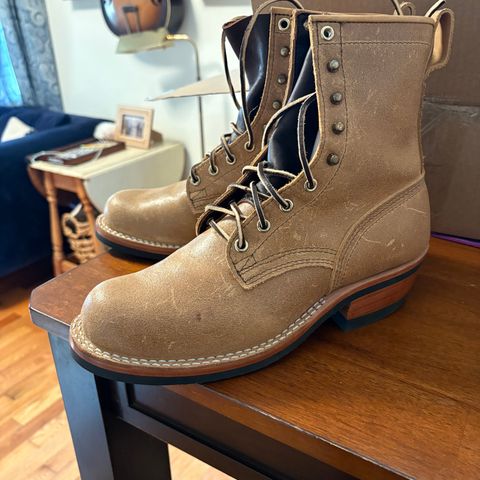About
Horween Latigo is a combination-tanned leather produced by Horween Leather Company using both chrome and vegetable tanning methods. The leather is characterized by its tight grain structure, waxy surface, and balanced flexibility between chrome-tanned and vegetable-tanned leathers. Horween produces Latigo through a proprietary process that includes a full vegetable re-tan and hot-stuffing with oils and waxes, resulting in a durable leather suitable for boots, belts, and outdoor gear.
About
Horween Latigo is a combination-tanned leather produced by Horween Leather Company using both chrome and vegetable tanning methods. The leather is characterized by its tight grain structure, waxy surface, and balanced flexibility between chrome-tanned and vegetable-tanned leathers. Horween produces Latigo through a proprietary process that includes a full vegetable re-tan and hot-stuffing with oils and waxes, resulting in a durable leather suitable for boots, belts, and outdoor gear.
The name "Latigo" derives from the Spanish word for whip, reflecting its original use in manufacturing leather whips and horse tack. In the 1970s, Horween Latigo became widely used by G.H. Bass for sandal production, demonstrating its versatility beyond traditional applications. The leather combines the strength characteristics of chrome tanning with the firmness and patina development of vegetable tanning.
Manufacturing process
Horween Latigo begins with cowhide that undergoes chrome tanning using chromium sulfate and chromium salts. Following the initial chrome tanning, the leather receives a full vegetable re-tan using plant-based tannins. This combination tanning method creates a leather with intermediate properties between pure chrome and pure vegetable-tanned leathers.
After the dual tanning process, the leather undergoes hot-stuffing or fat-liquoring with Horween's proprietary blend of oils and waxes. This treatment nourishes the leather and provides its characteristic waxy surface texture. The leather is then dried using traditional methods, including toggling on frames for seven to 10 days with air drying. Some production uses an eight-hour drying process depending on the specific requirements.
The raw leather typically measures approximately 4mm in thickness. Horween produces variations including standard Latigo and Illini Latigo, with the latter having a firmer temper compared to the standard line. The company has been manufacturing its own vegetable liquor at the tannery since 1905, contributing to the consistency of the vegetable re-tanning process.
Characteristics
Horween Latigo exhibits a tight grain pattern and smooth texture with a waxy feel resulting from the oil and wax treatments. The leather's flexibility falls between that of chrome-tanned and vegetable-tanned leathers, making it less flexible than Chromexcel but more flexible than full vegetable-tanned leather. This intermediate flexibility provides what manufacturers describe as a "middle ground" working characteristic.
The combination tanning gives Latigo both strength from the chrome base and firmness from the vegetable re-tan. The leather demonstrates good moisture resistance due to the high oil content, making it suitable for outdoor applications and sweaty conditions. Unlike purely vegetable-tanned leathers, Latigo cannot be effectively tooled or stamped because of its "bounce" characteristic that interferes with impression work.
Horween produces Latigo in both matte and glazed finishes, affecting the surface appearance and texture. The leather develops patina over time while maintaining its structural integrity. The oil and wax content provides a protective layer that contributes to the leather's longevity and weather resistance.
Applications
In footwear, Horween Latigo is particularly suited for work boots and hiking boots due to its durability and moisture resistance. The leather performs well in rugged applications where flexibility and toughness are required. Boot manufacturers often recommend Latigo for customers seeking smooth leather that resists scuffing better than softer options like Chromexcel, though it lacks the pull-up effect of oil-tanned leathers.
Heritage boot makers use Latigo for construction where initial stiffness is acceptable, as the leather molds to the foot with wear while maintaining its structural support. The leather's resistance to stretching makes it suitable for applications requiring dimensional stability. Some manufacturers note that Latigo may be too rigid for dress shoes like derbies or chukkas but works well for substantial boot construction.
Beyond footwear, Latigo is commonly used for belts, where its combination of flexibility and dimensional stability prevents stretching while providing comfortable wear. The leather's heritage in horse tack continues, with applications in saddle straps and related equipment. Boot laces made from Latigo benefit from the leather's slight waxiness, which aids in threading and provides water resistance.
History
The term "latigo" originates from Spanish, derived from the word for whip, reflecting the leather's initial primary use in manufacturing whips and horse tack. Early leather history records show that Poetsch & Peterson, a tannery founded in 1883 in San Francisco, California, gained recognition for producing golden latigo leather.
Before modern combination tanning methods, latigo underwent combination tanning with alum and gambier. The earlier alum tanning process used aluminum salts mixed with binders and protein sources such as flour or egg yolks. This historical method preceded the current chrome and vegetable combination tanning process.
In the 1970s, Horween Latigo experienced significant commercial success when G.H. Bass purchased large quantities for use in their sandals, making latigo leather one of Horween's highest-volume products during that period. Cowboy-focused leathermakers of this era would often crumple the leather before staining to create unique patterns for each pair of boots.
The evolution from traditional alum tanning to modern combination tanning reflects advances in leather chemistry and processing techniques. Contemporary Latigo retains the toughness associated with its working heritage while offering improved aesthetics and consistency compared to historical versions.
References
"Horween Latigo Leather". The Tannery Row. Retrieved September 5, 2025.
"Horween Latigo Leather". Oak Street Bootmakers. Retrieved September 5, 2025.
"Definitions". Horween Leather Company. Retrieved September 5, 2025.
"The Different Types of Horween Leathers We Use To Make Our Custom Shoe". HD Russell Boots & Shoes. Retrieved September 5, 2025.
"Latigo Leather - When to Use This Flexible, Durable Leather". International Leather Club. Retrieved September 5, 2025.
"The Tanning Process: A look inside the Horween Leather Company". The Tannery Row. Retrieved September 5, 2025.
